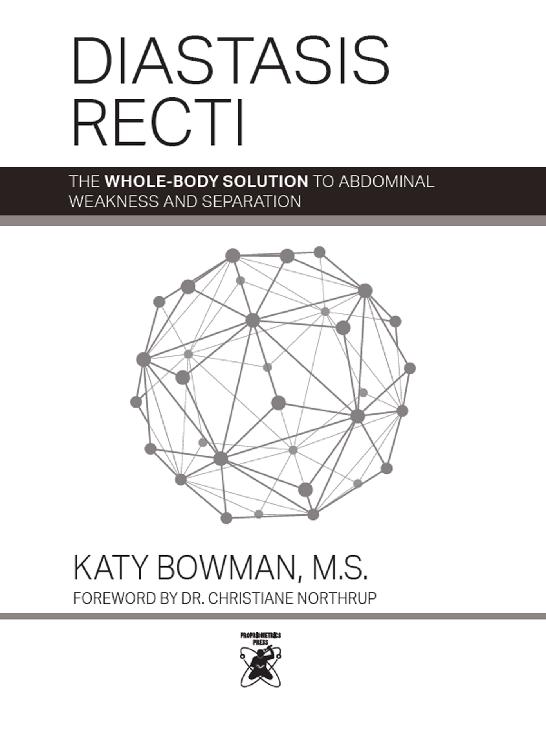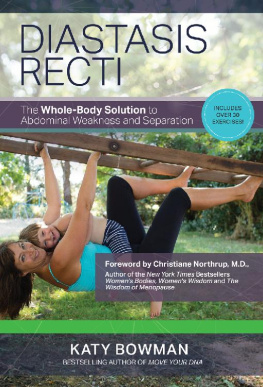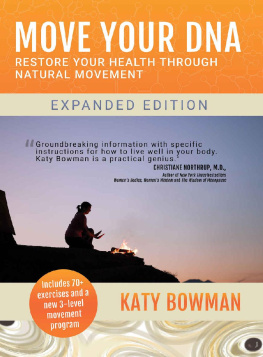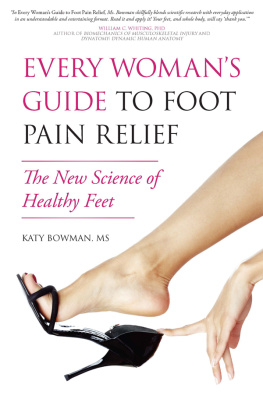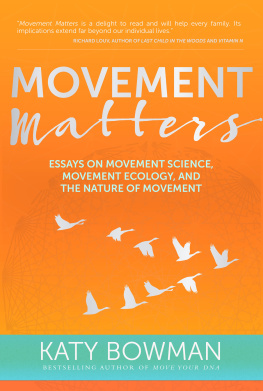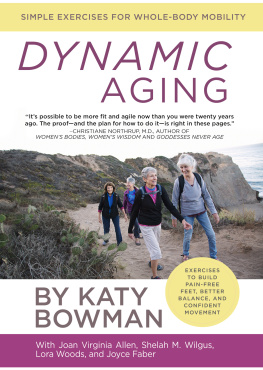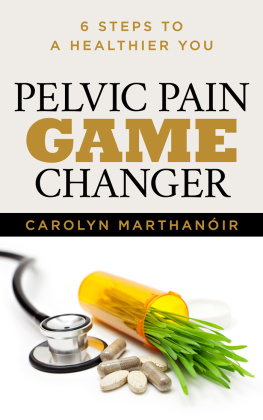ALSO BY KATY BOWMAN
Dont Just Sit There (Propriometrics Press, 2015)
Whole Body Barefoot (Propriometrics Press, 2015)
Move Your DNA (Propriometrics Press, 2014)
Alignment Matters (Propriometrics Press, 2013)
Every Womans Guide to Foot Pain Relief (BenBella, 2011)
Copyright Katy Bowman 2016
Foreword Christiane Northrup 2016
All rights reserved. No part of this publication may be reproduced, distributed, or transmitted in any form or by any means, including photocopying, recording, or other electronic or mechanical methods, without the prior written permission of the publisher, except in the case of brief quotations embodied in critical reviews and certain other noncommercial uses permitted by copyright law.
Printed in the United States of America.
First Printing, 2016
ISBN paperback: 978-0-9896539-6-1
Library of Congress Control Number: 2015953478
Propriometrics Press: propriometricspress.com
Cover and Interior Design: Zsofi Koller, zsofikoller.com
Illustrations: Jillian Nicol
Photography: J. Jurgensen Photography
Cover and interior graphics: shutterstock.com, vectorstock.com
The information in this book should not be used for diagnosis or treatment, or as a substitute for professional medical care. Please consult with your health care provider prior to attempting any treatment on yourself or another individual.
Publishers Cataloging-In-Publication Data
(Prepared by The Donohue Group, Inc.)
Bowman, Katy.
Diastasis recti : the whole-body solution to abdominal weakness and separation / Katy Bowman, M.S. ; foreword: by Dr. Christiane Northrup ; illustrations: Jillian Nicol.
pages : illustrations ; cm
Includes bibliographical references and index.
ISBN: 978-0-9896539-6-1 (paperback)
1. Abdomen--Muscles--Abnormalities--Therapy--Popular works. 2. Abdomen--Mechanical properties--Popular works. 3. Abdominal exercises--Popular works. 4. Human locomotion--Health aspects--Popular works. 5. Exercise therapy--Popular works. I. Northrup, Christiane. II. Nicol, Jillian. III. Title.
RC935.D53 B693 2016
616.7/406 2015953478
For Penelope. Not only couldnt I have written these books without out you, I wouldnt have written all these books without you. No, youre not allowed to edit this dedication. See?
CONTENTS
FOREWORD
A s an OB-GYN, Ive seen patients with a wide range of issues in the pelvic and abdominal area, many of them musculoskeletal. At best these issues are approached with spot treatments that temporarily fix a problem while often creating more long-lasting issues. At worst theyre dismissed entirely. And so Ive always sought alternative approaches to these conditionsI truly believe that people should have any and all information that allows them to live fully and happily in their own bodies.
I first found Katy Bowman through her revolutionary work on pelvic health. Instead of recommending a single corrective exercise, the Kegel, she was focusing on whole-body movements, including redeveloping the lost practice of squatting, as a solution to pelvic floor disorders. Her science-based work is what drew me in, but I stayed for her approachable and empowering message that each of us has the ability to change our bodies and make them more functionalthat you simply are how you move.
Her approach to diastasis recti is no less revolutionary. This abnormal separation of the abdominal musculature is not, as commonly thought, just an unfortunate side effect of pregnancy. It occurs across body types, genders, and ages. But the prevalence of DR has not been met with abundant research to attempt to understand this issue. Most people with a diastasis recti are told, Sorry, its natural, you need surgery.
This approach doesnt resonate with me. We are not passive recipients of diseases and conditions; we are active participants in our health and vitality.
Having someone tell you that your frustrating, inconvenient, or painful condition is natural and that surgery or difficult (and barely effective) spot treatments are your only options is both disempowering and possibly untrue. So much of our physical experience is created by how we choose to liveits not the result of some unavoidable genetic fate. You can learn how a diastasis recti comes about, and how to use your body in a way that allows it to function better, the way its supposed to.
And youve picked up the right book. In Diastasis Recti: A Whole-Body Solution to Abdominal Weakness and Separation , Katy lays out just how we can become active participants in healing and strengthening our core, by changing how we move. From the feet up, and all through our lives, weve been making choices that have created a diastasis recti, whether weve realized it or not. This book will not only teach you the exercises that can give you a more functional core but also help you make choices to keep you strong and vital. Once you realize how practical and how joyfully simple Katys you are how you move, so move a different way and youll feel better message is, youll begin to heal physically. Youll also feel authentically and fully in control of your body and your path to health. Your mind and body will be working in tandem to help you strengthen and heal faster than you imagined possible.
And the best part is, once you start resolving the deeper issues that created your diastasis in the first place, many other seemingly unrelated problems (were talking knee pain, backaches, headaches, even urinary incontinence) can begin to resolve as well. The practical solutions Katy presents in this bookmoving more mindfully, moving with your community, becoming more connected with the earth, eating body-healing foods, taking responsibility for how you feel and how you healaddress myriad issues. Imagine! All that in a book about diastasis recti!
I invite each and every one of you to take Katys and my shared message to heart: You have the power to create the body and life you deserve. Use it!
Christiane Northrup, MD
PREFACE
B efore we start detailing how a diastasis recti is made, and what you can do about it, Id like to share my story.
Ive given birth to two children, seventeen months apart. After the birth of my son, my first child, I ended up in bed for four days following surgery on one of my pelvic arteries. I was still in the blissful stage following the birth, so the time spent flat on my back (with a catheter, so I wasnt even walking to the bathroom) went by quickly, but when I went to stand up for the first time, I realized that labor and delivery followed by major pelvic surgery and then lying flat on my back for five days had left me without any strength. The hospital staff told me it would take at least ten weeks before I could walk with ease again. The difference between me and other patients, I suppose, was that I knew how to create exercises and a movement program that would build my functional strength back up so that I could stand, walk, and carry my newborn without pain.
I started training the day I got home from the hospital. I broke the eighth-of-a-mile walk around my block into steps, assessing which muscles my weak body wanted to use with each step and coaxing a different use pattern to get rid of any compensations brought about by my stint on bed rest that wouldnt serve me in the long run. It took me about a month to get back to normalnot to before the birth normal, but back on track to where I would have been were I not bed-ridden for those first few days. From there, it was a few more weeks before my pre-pregnancy strength returned. By the time I got pregnant againa surprisingly short eight months after my first babyI was stronger than I had been before being pregnant the first time, and my second (home) birth went smoothly.
